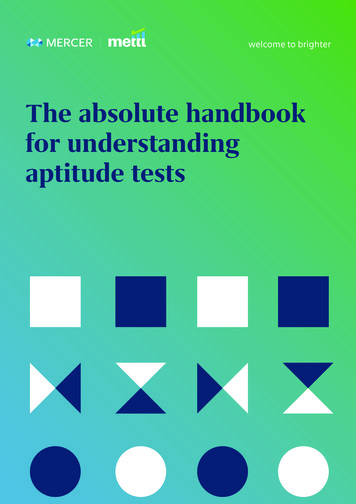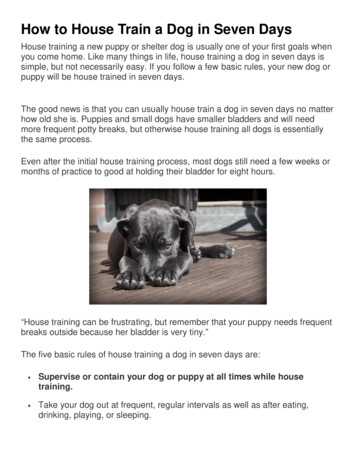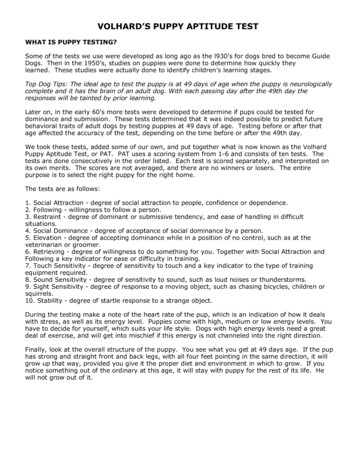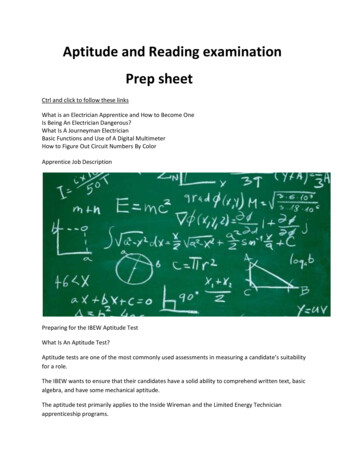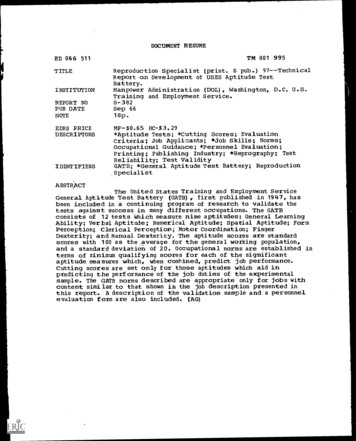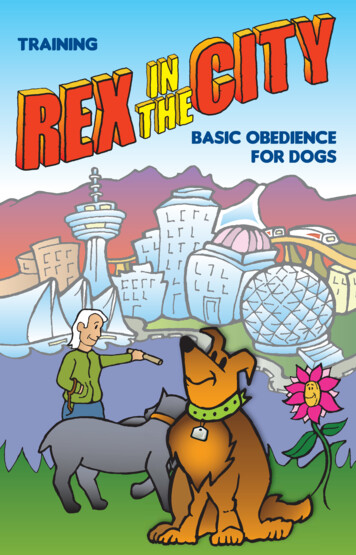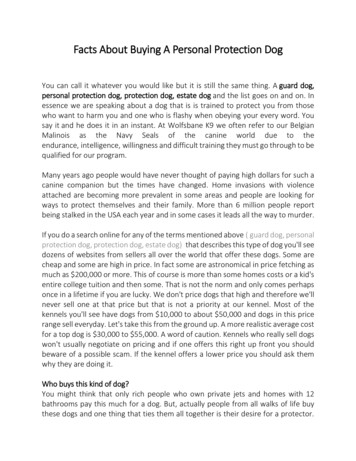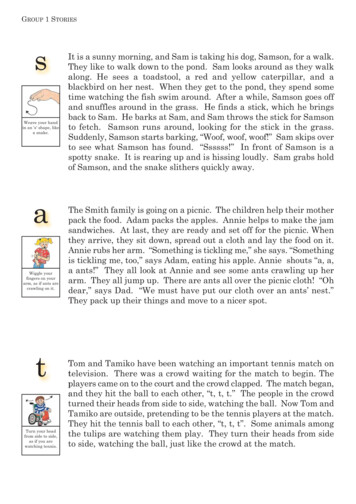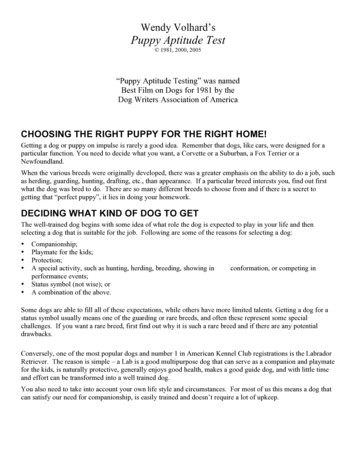
Transcription
Wendy Volhard’sPuppy Aptitude Test 1981, 2000, 2005“Puppy Aptitude Testing” was namedBest Film on Dogs for 1981 by theDog Writers Association of AmericaCHOOSING THE RIGHT PUPPY FOR THE RIGHT HOME!Getting a dog or puppy on impulse is rarely a good idea. Remember that dogs, like cars, were designed for aparticular function. You need to decide what you want, a Corvette or a Suburban, a Fox Terrier or aNewfoundland.When the various breeds were originally developed, there was a greater emphasis on the ability to do a job, suchas herding, guarding, hunting, drafting, etc., than appearance. If a particular breed interests you, find out firstwhat the dog was bred to do. There are so many different breeds to choose from and if there is a secret togetting that “perfect puppy”, it lies in doing your homework.DECIDING WHAT KIND OF DOG TO GETThe well-trained dog begins with some idea of what role the dog is expected to play in your life and thenselecting a dog that is suitable for the job. Following are some of the reasons for selecting a dog: Companionship;Playmate for the kids;Protection;A special activity, such as hunting, herding, breeding, showing inperformance events;Status symbol (not wise); orA combination of the above.conformation, or competing inSome dogs are able to fill all of these expectations, while others have more limited talents. Getting a dog for astatus symbol usually means one of the guarding or rare breeds, and often these represent some specialchallenges. If you want a rare breed, first find out why it is such a rare breed and if there are any potentialdrawbacks.Conversely, one of the most popular dogs and number 1 in American Kennel Club registrations is the LabradorRetriever. The reason is simple – a Lab is a good multipurpose dog that can serve as a companion and playmatefor the kids, is naturally protective, generally enjoys good health, makes a good guide dog, and with little timeand effort can be transformed into a well trained dog.You also need to take into account your own life style and circumstances. For most of us this means a dog thatcan satisfy our need for companionship, is easily trained and doesn’t require a lot of upkeep.
Wendy Volhard’sPuppy Aptitude Test 1981, 2000, 2005KEEPING UP APPEARANCESEveryone has his or her own preference and there is an enormous choice, from the four-pound Yorkshire Terrierto the 200-pound Mastiff. Many dogs come in different sizes, such as Poodles, or Schnauzers. Other have asmaller version that is similar in appearance, such as Collies and Shelties, or Dobermans and MiniaturePinschers, or German Shepherds and Corgis, or Greyhounds and Whippets, the “poor man’s race horse”.Tidbits: Poodles and Terriers don’t shed but have to be groomed regularly. Unless you are willing to spend thetime and effort learning how to do it yourself, this means periodic visits to a professional groomer, an expensiveproposition.Breeds with long hair require more upkeep than those with short hair. Pretty obvious when you think about it,but often completely overlooked when selecting a puppy or dog. Some breeds, like Briards, Poodles,Wirehaired Dachshunds and Terriers don’t shed, a most desirable feature. On the other hand, unless you arewilling to learn how to groom your dog, it means regular visits to the grooming parlor, visits that are not cheap.Some breeds, such as terriers and some of the herding dogs, bark a lot more than others. If you live in anapartment such a dog would not be a good choice.Bet You Didn’t Know: Why does the breed standard for many dogs sound so similar when describing the dog’stemperament? Because so many of them were written by the same man. In 1874, J.H. Walsh, under the penname of Stonehenge, published “The Dog: Its Varieties and Management in Health”, the first major effort todescribe the more than 60 breeds recognized at that time.THE TIME FACTORIn selecting a dog or puppy be aware of the time factor. How much exercise does this particular breed requireand are you in a position to give it to your dog? Some breeds require less exercise than others, but many require2 daily 20-minute walks, at a minimum, and some, such as the Sporting breeds, much more. Just letting the dogout in a backyard is not sufficient.In the selection process you need to remind yourself continuously that your dog is going to be with youanywhere from 8 to 16 years. And, the older he or she gets, the more important regular exercise becomes.How much time do you have available to devote to training that cute little bundle of fur? If you have little orno more that 10 to 15 minutes a day, then you need to select a breed that is easily trained and doesn’t requiremuch exercise.
Wendy Volhard’sPuppy Aptitude Test 1981, 2000, 2005WHAT ARE YOU LOOKING FORA good place to start is The Complete Dog Book by the American Kennel Club, which describes the breedstandards for the different breeds recognized by that organization. Two other excellent resources are RogerCaras Dog Book: A Complete Guide to Every AKC Breed (Dorset Press, 1992) and Paws to Consider:Choosing the Right Dog for You and Your Family by Brian Kilcommons and Sarah Wilson (Grand CentralPublishing, 1999).Another wealth of information can be found at dog shows, where you can see a large variety of breeds and talkto their owners and breeders. But remember, they are obviously and naturally biased.To help you get the dog you want we have devised a simple test, which is amazingly accurate in predictinginherited behavioral tendencies and how the puppy will turn out as an adult.WHAT IS PUPPY TESTING?Some of the tests we use were developed as long ago as the l930’s for dogs bred to become Guide Dogs. Thenin the 1950’s, studies on puppies were conducted to determine how quickly they learned. These studies wereactually done to identify children’s learning stages.Top Dog Tips: The ideal age to test the puppy is at 49 days of age when the puppy is neurologically completeand it has the brain of an adult dog. With each passing day after the 49th day the responses will be tainted byprior learning.Later on in the early 60’s more tests were developed to determine if pups could be tested for dominance andsubmission. These tests determined that it was indeed possible to predict future behavioral traits of adult dogsby evaluating puppies at 49 days of age. Testing before or after that age, effected the accuracy of the results,depending on the amount of time before or after the 49th day.We took these tests, added some of our own, and put together what is now known as the Volhard PuppyAptitude Test, or PAT. PAT uses a scoring system from 1-6 and consists of ten tests. The tests are doneconsecutively and in the order listed. Each test is scored separately, and interpreted on its own merits. Thescores are not averaged, and there are no winners or losers. The entire purpose is to select the right puppy forthe right home.
Wendy Volhard’sPuppy Aptitude Test 1981, 2000, 2005The Tests Consist of the Following:1. Social Attraction - degree of social attraction to people, confidence or dependence.2. Following - willingness to follow a person.3. Restraint - degree of dominant or submissive tendency, and ease of handling in difficult situations.4. Social Dominance - degree of acceptance of social dominance by a person.5. Elevation - degree of accepting dominance while in a position of no control, such as at the veterinarian orgroomer.6. Retrieving - degree of willingness to do something for you. Together with Social Attraction and Following akey indicator for ease or difficulty in training.7. Touch Sensitivity - degree of sensitivity to touch and a key indicator to the type of training equipmentrequired.8. Sound Sensitivity - degree of sensitivity to sound, such as loud noises or thunderstorms.9. Sight Sensitivity - degree of response to a moving object, such as chasing bicycles, children or squirrels.10 Stability - degree of startle response to a strange object.During the testing make a note of the heart rate of the pup, which is an indication of how it deals with stress, aswell as its energy level. Puppies come with high, medium or low energy levels. You have to decide foryourself, which suits your life style. Dogs with high energy levels need a great deal of exercise, and will getinto mischief if this energy is not channeled into the right direction.Finally, look at the overall structure of the puppy. You see what you get at 49 days age. If the pup has strongand straight front and back legs, with all four feet pointing in the same direction, it will grow up that way,provided you give it the proper diet and environment in which to grow. If you notice something out of theordinary at this age, it will stay with puppy for the rest of its life. He will not grow out of it.
Wendy Volhard’sPuppy Aptitude Test 1981, 2000, 2005HOW TO TESTHere are the ground rules for performing the test:The testing is done in a location unfamiliar to the puppies. This does not mean they have to taken away fromhome. A 10-foot square area is perfectly adequate, such as a room in the house where the puppies have notbeen.The puppies are tested one at a time. There are no other dogs or people, except the scorer and the tester, in the testing areaThe puppies do not know the tester.The scorer is a disinterested third party and not the person interested in selling you a puppy.The scorer is unobtrusive and positions him or herself so he or she can observe the puppies’ responseswithout having to move.The puppies are tested before they are fed.The puppies are tested when they are at their liveliest.Do not try to test a puppy that is not feeling well.Puppies should not be tested the day of or the day after being vaccinated.Only the first response counts!Top Dog Tips: During the test, watch the puppy’s tail. It will make a difference in the scoring whether the tailis up or down.The tests are simple to perform and anyone with some common sense can do them. You can, however, elicitthe help of someone who has tested puppies before and knows what they are doing.1. Social attraction - the owner or caretaker of the puppies places it in the test area about four feet from thetester and then leaves the test area. The tester kneels down and coaxes the puppy to come to him or her byencouragingly and gently clapping hands and calling. The tester must coax the puppy in the oppositedirection from where it entered the test area. Hint: Lean backward, sitting on your heels instead of leaningforward toward the puppy. Keep your hands close to your body encouraging the puppy to come to youinstead of trying to reach for the puppy.2. Following - the tester stands up and slowly walks away encouraging the puppy to follow. Hint: Make surethe puppy sees you walk away and get the puppy to focus on you by lightly clapping your hands and usingverbal encouragement to get the puppy to follow you. Do not lean over the puppy.3. Restraint - the tester crouches down and gently rolls the puppy on its back and holds it on its back for 30seconds. Hint: Hold the puppy down without applying too much pressure. The object is not to keep it onits back but to test its response to being placed in that position.4. Social Dominance - let the puppy stand up or sit and gently stroke it from the head to the back while youcrouch beside it. See if it will lick your face, an indication of a forgiving nature. Continue stroking untilyou see a behavior you can score. Hint: When you crouch next to the puppy avoid leaning or hovering overthe puppy. Have the puppy at your side with both of you facing in the same direction.
Wendy Volhard’sPuppy Aptitude Test 1981, 2000, 2005Top Dog Tips: During testing maintain a positive, upbeat and friendly attitude toward the puppies. Try toget each puppy to interact with you to bring out the best in him or her. Make the test a pleasant experiencefor the puppy.5. Elevation Dominance - the tester cradles the puppy with both hands, supporting the puppy under its chestand gently lifts it two feet off the ground and holds it there for 30 seconds.6. Retrieving - the tester crouches beside the puppy and attracts its attention with a crumpled up piece of paper.When the puppy shows some interest, the tester throws the paper no more than four feet in front of thepuppy encouraging it to retrieve the paper.7. Touch Sensitivity - the tester locates the webbing of one the puppy’s front paws and presses it lightlybetween his index finger and thumb. The tester gradually increases pressure while counting to ten and stopswhen the puppy pulls away or shows signs of discomfort.8. Sound Sensitivity - the puppy is placed in the center of the testing area and an assistant stationed at theperimeter makes a sharp noise, such as banging a metal spoon on the bottom of a metal pan.9. Sight Sensitivity - the puppy is placed in the center of the testing area. The tester ties a string around a bathtowel and jerks it across the floor, two feet away from the puppy.10. Stability - an umbrella is opened about five feet from the puppy and gently placed on the ground.
Wendy Volhard’sPuppy Aptitude Test 1981, 2000, 2005SCORING THE RESULTSFollowing are the responses you will see and the score assigned to each particular response. You will see somevariations and will have to make a judgment on what score to give them.TestSOCIAL ATTRACTIONFOLLOWINGRESTRAINTSOCIAL DOMINENCEResponseCame readily, tail up, jumped, bit athandsCame readily, tail up, pawed, licked athandsCame readily, tail upCame readily, tail downCame hesitantly, tail downDid not come at allFollowed readily, tail up, gotunderfoot, bit at feetFollowed readily, tail up, got underfootFollowed readily, tail upFollowed readily, tail downFollowed hesitantly, tail downDid not follow or went awayStruggled fiercely, flailed, bitStruggled fiercely, flailedSettled, struggled, settled with someeye contactStruggled, then settledNo struggleNo struggle, strained to avoid eyecontactJumped, pawed, bit, growledJumped, pawedCuddled up to tester and tried to lickfaceSquirmed, licked at handsRolled over, licked at handsWent away and stayed awayScore123456123456123456123456
Wendy Volhard’sPuppy Aptitude Test 1981, 2000, 2005TestResponseELEVATION DOMINANCE Struggled fiercely, tried to biteStruggled fiercelyStruggled, settled, struggled, settledNo struggle, relaxedNo struggle, body stillNo struggle, body frozeRETRIEVINGChased object, picked it up and ranawayChased object, stood over it and didnot returnChased object, picked it up andreturned with it to testerChased object and returned without itto testerStarted to chase object, lost interestDoes not chase objectTOUCH SENSITIVITY8-10 count before response6-8 count before response5-6 count before response3-5 count before response2-3 count before response1-2 count before responseSOUND SENSITIVITYListened, located sound and rantoward it barkingListened, located sound and walkedslowly toward itListened, located sound and showedcuriosityListened and located soundCringed, backed off and hid behindtesterIgnored sound and showed nocuriosityScore123456123456123456123456
Wendy Volhard’sPuppy Aptitude Test 1981, 2000, 2005TestSIGHT SENSITIVITYSTABILITYResponseLooked, attacked and bit objectLooked and put feet on object and putmouth on itLooked with curiosity and attempted toinvestigate, tail upLooked with curiosity, tail downRan away or hid behind testerHid behind testerLooked and ran to the umbrella,mouthing or biting itLooked and walked to the umbrella,smelling it cautiouslyLooked and went to investigateSat and looked, but did not movetoward the umbrellaShowed little or no interestRan away from the umbrellaScore123456123455
Wendy Volhard’sPuppy Aptitude Test 1981, 2000, 2005WHAT DO THE SCORES MEAN?The scores are interpreted as follows:Mostly 1’s Strong desire to be pack leader and is not shy about bucking for a promotionHas a predisposition to be aggressive to people and other dogs and will biteShould only be placed into a very experienced home where the dog will be trained and worked on a regularbasisTop Dog Tips: Stay away from the puppy with a lot of 1’s or 2’s. It has lots of leadership aspirations and maybe difficult to manage. This puppy needs an experienced home. Not good with children.Mostly 2’s Also has leadership aspirationsMay be hard to manage and has the capacity to biteHas lots of self-confidenceShould not be placed into an inexperienced homeToo unruly to be good with children and elderly people, or other animalsNeeds strict schedule, loads of exercise and lots of trainingHas the potential to be a great show dog with someone who understands dog behaviorMostly 3’s-Can be a high-energy dog and may need lots of exerciseGood with people and other animalsCan be a bit of a handful to live withNeeds training, does very well at it and learns quicklyGreat dog for second time owner.Mostly 4’s-The kind of dog that makes the perfect pet Best choice for the first time owner.Rarely will buck for a promotion in the familyEasy to train, and rather quiet.Good with elderly people, children, although may need protection from the childrenChoose this pup, take it to obedience classes, and you’ll be the star, without having to do too much work!Tidbits: The puppy with mostly 3’s and 4’s can be quite a handful, but should be good with children and doeswell with training. Energy needs to be dispersed with plenty of exercise.
Wendy Volhard’sPuppy Aptitude Test 1981, 2000, 2005Mostly 5’s Fearful, shy and needs special handlingWill run away at the slightest stress in its lifeStrange people, strange places, different floor or ground surfaces may upset itOften afraid of loud noises and terrified of thunder storms. When you greet it upon your return, maysubmissively urinate. Needs a very special home where the environment doesn’t change too much and wherethere are no childrenIf cornered and cannot get away, has a tendency to biteTop Dog Tips: Avoid the puppy with several 6’s. It is so independent it doesn’t need you or anyone. He is hisown person and unlikely to bond to you.Mostly 6’s-So independent that he doesn’t need you or other peopleDoesn’t care if he is trained or not - he is his own person. Not likely to bond to you, since he doesn’t need you.A great guard dog for gas stations!Do not take this puppy and think you can change him into a lovable bundle - you can’t, so leave well enoughaloneINTERPRETING THE SCORESFew puppies will test with all 2’s or all 3’s - there will be a mixture of scores.For that first time, wonderfully easy to train, potential star, look for a puppy that scores with mostly 4’s and 3’s.Don’t worry about the score on Touch Sensitivity - you can compensate for that with the right trainingequipment.Tidbits: It’s hard not to become emotional when picking a puppy - they are all so cute, soft and cuddly. Remindyourself that this dog is going to be with you for 8 to 16 years. Don’t hesitate to step back a little tocontemplate your decision. Sleep on it and review it in the light of day.Avoid the puppy with a score of 1 on the Restraint and Elevation tests. This puppy will be too much for thefirst time owner.It’s a lot more fun to have a good dog, one that is easy to train, one you can live with and one you can be proudof, than one that is a constant struggle.CHOOSING A BREEDEROnce you have done your research and you have decided which breed is most suited to your lifestyle andexpectations, it is time to choose a breeder. You can meet breeders at dog shows, through the local newspaper,or popular dog Magazines, such as The American Kennel Club Gazette, Dog World or Dog Fancy.
Wendy Volhard’sPuppy Aptitude Test 1981, 2000, 2005Here are some of the criteria you want to follow in selecting a breeder: Choose an experienced breeder, one who has had several litters and who knows his breed.Choose a breeder who has shown his dogs and has done some winning, which is a fairly good indication thathis or her dogs conform to the standard of the breed and will grow up looking like the dogs you saw thatattracted you to the breed in the first place.Choose a breeder who is using our Puppy Aptitude Test. If he or she hasn’t heard of it, show it to them;avoid one that says “I don’t believe in that.”Choose a breeder whose dogs are certified by the applicable registries against breed-related geneticdisorders, such as eyes, hips, etc.Choose a breeder where you can interact with adult dogs, and get some idea how long they live.Choose a breeder where the dogs are well housed and everything is clean.The majority of breeders today show a great willingness to have their puppies tested, and are interested in theresults. It shows them the inherited behaviors of their breeding stock, valuable information for future breeding.The results make it easier for them to place the right puppy into the right home where people will be happy withthem. After all, no breeder wants a puppy returned when it’s 8 months old and may have been ruined by beingimproperly brought up.Whatever you do, don’t try to pick a puppy by having the entire litter together - you will not be able to pick theright one for you. Always interact with a puppy individually, away from its litter mates.GETTING A DOG FROM A SHELTERDon’t overlook an Animal Shelter as a source for a good dog. Not all dogs wind up in a shelter because theyare bad. After that cute puppy stage, when the dog grows up, it may become too much for its owner. Or, therehas been a change in the owner’s circumstances forcing him or her into having to give up the dog.Most of the time these dogs are housetrained and already have some training. If the dog has been properlysocialized to people, it will be able to adapt to a new environment. Bonding may take a little longer, but onceaccomplished, result in a devoted companion.While you can’t use the entire puppy test, there are some tests that will give you a good indication of what tolook for.1. Restraint - try putting the dog into a down position with some food, and then gently rolling him over and seewhat happens. If the dog jumps up and runs away or tries to bite you, this is not the dog for you. Ratherlook for a dog that turns over readily, but squirms around a bit. Apply just enough pressure to keep the dogon its back; ease up if it struggles too much. Intermittent squirming is OK, constant squirming is not OK.2. Social Dominance - directly after the Restraint Test, if the dog didn’t struggle too much and if you think it’ssafe, try sitting the dog and just stroking him, getting your face relatively close to him talking to him softly,to see if he licks you and forgives you for the upside down experience. A dog that wants to get away fromyou is not a good candidate.3. Retrieving - crumple up a small piece of paper and show it to the dog. Have him on your left side with yourarm around him and throw the paper with your right hand about six feet, encouraging the dog to get it andbring it back. You are looking for a dog that brings the paper back to you.
Wendy Volhard’sPuppy Aptitude Test 1981, 2000, 2005Guide dog trainers have the greatest faith in this test. A dog that retrieves nearly always works out to be aGuide Dog because it indicates a willingness to work for the owner. Other organizations that use dogs from ashelter, such as those who use dogs to sniff out contraband or drugs, and police departments, place almost solereliance on this test. They know that if a dog brings back the object, they can train him to do almost anything.Wherever you get your dog, use the tests that you can do and act accordingly. By the way, it’s not too late touse some of the tests with the dog you already have. It just might explain some of your dog’s behaviors.THE LEAST YOU NEED TO KNOW There are many breeds to choose from and if there is a secret in getting that “perfect puppy”, it is doing yourhomework.A good place to start is “The Complete Dog Book” by the American Kennel Club, which describes in detailthe different breeds recognized by that registry.Carefully consider the time you have available for the necessary up-keep and exercise the dog requires.Don’t get a dog on impulse!Use the Volhard Puppy Aptitude Test in selecting your dog, whether a puppy or an older dog.
We took these tests, added some of our own, and put together what is now known as the Volhard Puppy Aptitude Test, or PAT. PAT uses a scoring system from 1-6 and consists of ten tests. The tests are done consecutively and in the order listed. Each test is
